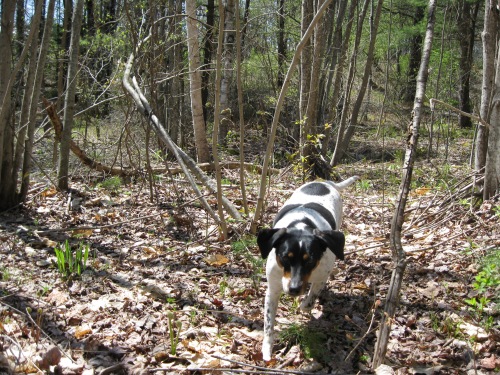Truly original. Lived nearly 12 full years at Nixie’s Vale.
The best partner in local adventures a gal could ask for. Probably a Purina model in Arkansas, 2008. After her brief modeling career ended in disaster, she and her heinous sister were found in Hot Springs on the side of a highway. In a twist of fate, she ended up in Maine, and I adopted her in August 2009, a few months after moving to Nixie’s Vale. She saved lives, stole hearts and cured children’s cynophobia. The local code enforcement officer declared her an “exception to the ‘no dogs’ rule,” at the lake beach but she preferred the ocean, river and marshes. Sometimes she disappeared for hours and came back from the Bog of Eternal Stench (or Fern Gully) with black stockings and a story. In her youth, she dated a neighborhood pit bull with a bad reputation and loyally sat by his side even when he sat in the middle of the busy road. A shady past. Then she fell for a German Shepherd next door named Trooper, and she’d just let him into the house, and I’d come down to find them sitting side by side on the couch– no other people present, and she’d look over and tell him, “Yeah my Mom said.”












An unusual mix, she balanced her occupations between shoreline assessment, detective, and Head Rodent Terminator. In her spare time, she liked stealing index cards, collecting cans, and digging a trench beside the deck to relax and daydream. On rainy days, we still went outside (she wore a raincoat, reluctantly) or we’d stay inside, and she’d camp out on her bed (or the sofa with me) while I worked. If we were in the car, she rocked out to Pearl Jam with me.
She was, after all, my little Force of Nature.
From 2009-2013, she assisted in visiting wetlands throughout Maine, especially salt marshes, freshwater marshes, seeps, forested wetlands, land trust preserves, coastal reserves, coastal wetlands including eelgrass meadows and riverine / estuarine wetlands to pose as a model, or assist in capturing the beauty of Maine wetlands for the newsletters, formerly known as “Wetland Breaking News” and “Wetland News” for the nonprofit organization, ASWM with its HQ based in Maine. She had many admirers and fans.

As a shoreline assessment specialist, she conducted inventories on crabs, assessing whether they were alive or dead, and ate the dead ones. Sophie-Bea cultivated an interdisciplinary skill set over the years: she assisted in several phytoplankton tows in Feb-March 2018 in Cape Elizabeth, Maine; she assisted in a seaweed identification and macroalgae collection project (Southern Maine Community College, April-May 2018) especially at Kettle Cove State Park, Fort Williams State Park, and Two Lights State Park, where she assisted in sniffing seaweed and pulling rockweed away from rocks to identify a) crabs, b) red algaes, and c) periwinkles. Her love for the shoreline, careful footwork in deeper tide pools, and enthusiastic wading into the surf at Fort Williams Park (where dogs are allowed on the beach) were just a bonus.
At Fort Williams Park, the dog park— she told everyone she was a former circus performer who could jump through fire, survive thrombocytopenia and that one time she jacked deer—– and two HUGE St. Bernard Husky mixes, Tag and the Warden, became her bodyguards for three weeks after that unfortunate incident with a gang of standard poodles in the “leashless and lawless” section of the park. She’d walk between the two large St. Bernard Huskies like Lady Gaga with her bodyguards. But she was really Elizabeth Taylor in the form of a dachshund-pointer.
I loved her madly.
She fought a valiant battle with heart disease and congestive heart failure for over two years. But that did not stop her from living out wild mini adventures at least while on a 50′ cloth training leash and usually just in her back yard last summer and fall.


Theme Song lyrics: “Damn! I wish I was your guard dog.” and from Pearl Jam’s “Force of Nature,” “Understand She’s a Force of Nature / Contraband hiding deep inside her soul.”





